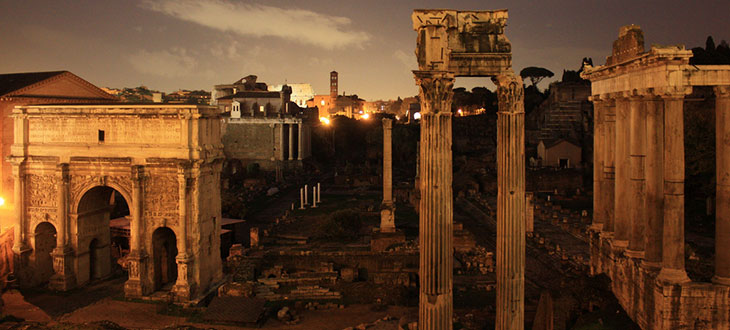Dinner At Piso's

marfis75 via flickr | http://bit.ly/1z8rHVh
Image rights: http://bit.ly/1dWcOPS
(Inside Science) -- Let's pretend it is 56 B.C. and you have been fortunate enough to be invited to a party at the home of Lucius Calpurnius Piso Caesoninus, a great social coup. Piso, after all, was Julius Caesar's father-in-law and a consul of Rome.
What's for dinner?
You need to prepare for pig. Archaeologists studying the eating habits of ancient Etruscans and Romans have found that pork was the staple of Italian cuisine before and during the Roman Empire. Both the poor and the rich ate pig as the meat of choice, although the rich, like Piso, got better cuts, ate meat more often and likely in larger quantities.
They had pork chops and a form of bacon. They even served sausages and prosciutto; in other words, a meal not unlike what you'd find in Rome today -- or in South Philadelphia.
Researchers discussed this ancient Mediterranean diet at a meeting of the Archaeological Institute of America in New Orleans in January.
Dinner parties were the way the Roman aristocracy showed off their wealth and prestige, according to Michael MacKinnon, professor of archaeology at the University of Winnipeg, Manitoba, Canada.
Status in the upper class was declared with the presentation of the meal, the rare spices, the dinnerware, he explained.
"The wealthier you are the more you want to invest in display and advertising to your guests. Flash was perhaps more important than substance," said MacKinnon. "Whole animals showed great wealth."
Besides the meat, there would be vegetables that looked little different from what we eat, said Angela Trentacoste of the University of Sheffield in the United Kingdom. Except for grain, which was imported in huge quantities from places like North Africa, everything was locally grown.
MacKinnon and Trentacoste are zooarchaeologists, scientists who study the remains of animals found in archaeological sites. They rummaged through ancient garbage dumps or middens, and occasionally even ancient latrines looking for the bones of animals and fish people ate. People would sometimes dump the garbage in the latrine instead of walk to the neighborhood dump, MacKinnon said. They can deduce a great deal from the bones about what life was like.
They also can often piece together a typical diet based on recovered porcelain shards.
They can look at bones in a dump and can tell what the animal was, sometimes how it was slaughtered, where it came from, and how the food supply worked.
For instance, if one site had nothing but feet bones, "It tells us that things were marketed and better cuts went elsewhere," he said.
Zooarchaeologists also have literary evidence of what was eaten from writers such as Juvenal and the poet Martial, often in satirical plays where writers mocked the ostentatious indulgence.
Trentacoste specializes in the Etruscan civilization that preceded Rome in Italy. Much of her digging was in the tombs of rich Etruscans who often were buried with food and utensils. On some sites, she found 20,000 animal bones amid the rubbish.
As the hegemony of Rome grew so did the city and what was a largely rural Etruscan society became a more urban Roman one, she said. That changed the food supply. Most food, as now, came from farms outside the city.
But, the city dwellers still raised pigs. They take up little room, can be easily bred and transported, Trentacoste said, and are easy to raise.
They also had chickens roaming the yards that looked much like the chickens of today, MacKinnon said, and they were close to the same size. Modern farmers use breeding and nutrition to make the chickens grow faster, but eventually Roman chickens would catch up. Cattle take up too much room but rich Romans had beef occasionally, and sometimes goat.
The lower classes ate to stay alive.
Some historians believed the lower class was mostly vegetarian but that is not true, MacKinnon and Trentacoste said. The generally ate the same things the upper class did, but not the same cuts (think mutton versus lamp chops) and probably not in the same quantities. The rich reclined as they ate.
Lower class Romans did not have fancy flatware, instead they used crude utensils.
Low-fat food was not in vogue because the fat would protect meat from spoilage in a world without refrigerators.
Because only the upper class had kitchens at home, other Romans bought food from street vendors, something like the lunch wagons of today. Mostly, MacKinnon said, they would put the food in large pots and make stews or a porridge. They might also boil the meat.
Only the wealthy were able to broil or barbecue.
Despite legend, most Romans or Etruscans did not often eat exotic animals regularly, although upper class diners might enjoy songbirds swallowed whole and one midden in Rome contained the bones of a slaughtered camel. Trentacoste said songbirds are still eaten in some parts of Italy. Pizza had yet not been invented.
One legend is true, MacKinnon said. There might be so much food at Piso's table, and everyone would want to indulge. To make room, they would excuse themselves from the table and purge.

